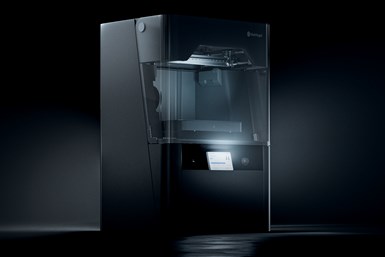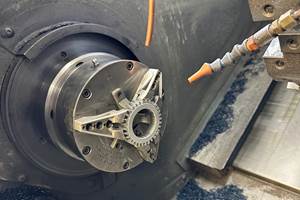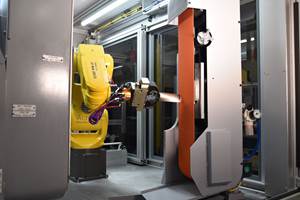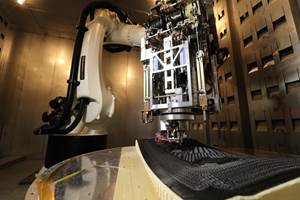Markforged’s FX10 Industrial 3D Printer Replaces Metal Parts With Advanced Composites
This fifth-generation print system features built-in automation for quality assurance and print routines designed to deliver strong, accurate parts every print.
The Markforged FX10 industrial 3D printer prints continuous carbon fiber-reinforced parts for a wide range of factory floor applications. Photo Credit: Markforged
Markforged’s FX10 industrial 3D printer is designed with flexibility in mind, with the printer’s modular systems engineered to be expanded and upgraded with additional capabilities. For example, the FX10 has been designed to incorporate a printhead integrated vision module to capture detailed part images and data to further ensure part quality and optimize printer performance.
The 5th Generation continuous fiber reinforcement (CFR) print system delivers high print quality in a heated print chamber that enables print speeds that are nearly twice as fast and print sizes that are up to twice as large as previous Markforged industrial series printers, enabling the replacement of metal parts with advanced composites.
The FX10 prints continuous carbon fiber-reinforced parts for a wide range of factory floor applications — helping manufacturers increase speed to market, slash fabrication and inventory costs, and de-risk line down events. The two printhead-mounted optical sensors automatically verify the dimensional accuracy of parts during the print to ensure consistency and reliability, while also assessing machine health and performance
The laser micrometer in the FX10 scans parts during printing and assists with the machine’s automatic calibration, while the new Vision Module captures detailed images of calibration parts to determine and optimize printer performance. Inspection software interprets the data from the sensors for dimensional verification, providing users with quality assurance as soon as a print finishes.
The material drawer of the FX10 contains built-in, individually sealed storage bays for up to four 800-cc spools. FX10 is able to automatically execute spool changeovers between filament storage bays during a print, and users can reload empty spool bays without disrupting a print.
The FX10 was designed to ensure easy adoption on the manufacturing floor starting with the first line operator. The system features a 7" touchscreen. A simple touchscreen interface combined with new automation and quality assurance technologies enable users to get more parts out of the FX10 with fewer interactions needed by the operator before and during a print than with previous Markforged printers. Users can start builds, monitor machine status, manually control the machine and start automated calibration routines all in one place.
The printer operates on the Digital Forge, which is Markforged’s additive platform that features intuitive device and desktop software, training and built-in cost calculation. Users can start generating ROI on day one and effortlessly scale to more teams, machines and facilities. A complete AM platform consisting of printers, cloud-enabled software with process improvement tools and a wide range of industrial materials, The Digital Forge is purpose-built to integrate into existing manufacturing ecosystems. With the Digital Forge, users can share parts across their organization and monitor fleet performance from a central location.
“We engineered the FX10 to be the best tool for the manufacturing floor,” says Shai Terem, Markforged CEO. “The FX10 allows manufacturers to slash original part replacement costs when compared to traditional methods and keep production lines running without worrying about supply chain issues or spare parts inventory. The FX10 can accelerate the digitization of the manufacturing floor by increasing the adoption of digital inventory to build supply chain resiliency. Our customers now have the potential to save even more capital by reducing physical inventory and boosting production yields, while decreasing operating costs.”
The FX10 printer is designed to supercharge manufacturing line productivity and profitability. The company says the printer empowers users to print the right part when and where it is needed, thereby reducing costs and cutting lead times from months to days, compared to traditional manufacturing methods.
“The FX10 is another important milestone in our mission to bring industrial production to the point of need. It enables our customers to address even more industrial applications with clear return on investment. Coupled with our Digital Source platform, we are truly starting to bring the vision of distributed manufacturing into reality,” Terem says. “The FX10 features a full suite of automation built to simplify the usage of the printer and increase adoption to build resiliency into our customers’ production. When a line is down or a tool is needed, FX10 users can simply press Print.”
- Check out the latest materials from Markforged as it reformulates H13, D2 tool steel for more flexible, less brittle filaments, which are reformulations of Markforged’s most popular tool steels.
- Read about Markforged’s Digital Source Platform which enables printing parts on-demand. The platform enables manufacturer-certified parts to be licensed and printed at the point of need.
Related Content
Copper, New Metal Printing Processes, Upgrades Based on Software and More from Formnext 2023: AM Radio #46
Formnext 2023 showed that additive manufacturing may be maturing, but it is certainly not stagnant. In this episode, we dive into observations around technology enhancements, new processes and materials, robots, sustainability and more trends from the show.
Read MoreChuck Jaws Achieve 77% Weight Reduction Through 3D Printing
Alpha Precision Group (APG) has developed an innovative workholding design for faster spindle speeds through sinter-based additive manufacturing.
Read MoreAircraft Engine MRO: How Additive Manufacturing Plus Robotic Finishing Will Expand Capacity for Blade Repair
AM offers the chance to bring fast, automated processing to individualized, part-by-part restoration of turbomachinery. A cell developed by Acme Manufacturing and Optomec is able to automatically repair 85,000 unique aircraft engine blades per year.
Read MoreHow 3D Printing Will Change Composites Manufacturing
A Q&A with the editor-in-chief of CompositesWorld explores tooling, continuous fiber, hybrid processes, and the opportunities for smaller and more intricate composite parts.
Read MoreRead Next
Video: Intelligent Layering Metal 3D Printing at 3DEO
Contract manufacturer 3DEO delivers metal parts using Intelligent Layering, a binder jetting-like 3D printing process the company developed and operates internally. Here’s how it works.
Read MoreLooking to Secure the Supply Chain for Castings? Don't Overlook 3D Printed Sand Cores and Molds
Concerns about casting lead times and costs have many OEMs looking to 3D print parts directly in metal. But don’t overlook the advantages of 3D printed sand cores and molds applied for conventional metal casting, says Humtown leader.
Read MoreTo Improve Performance of Compression Molded Composites, Add 3D Printed Preforms
9T Labs' Additive Fusion Technology enables the manufacture of composite structures with as much or as little reinforcement as is necessary, using 3D printed continuous fiber preforms to add strength just where needed.
Read More











.png;maxWidth=300;quality=90)












